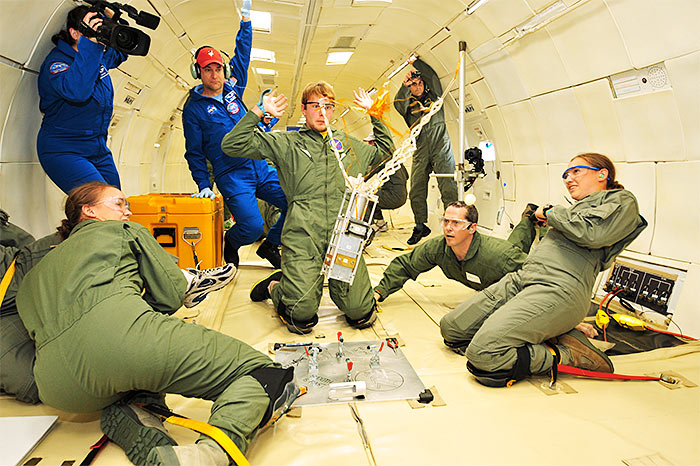
Here’s another example showing the utility of human-tended experiments on parabolic flights for technology development. This time, it’s low-cost CubeSat hardware.
Cadets at the US Air Force Academy are developing an innovative space-based solar telescope called FalconSAT-7.
Instead of a primary lens or mirror, FalconSAT-7 uses a 0.2-meter membrane called a photon sieve. Millions of tiny holes in the sieve focus the light through difraction. The photon sieve, which is less expensive to fabricate than a lens or mirror, can be folded into a compact, lightweight package for launch.
The FalconSAT-7 mission, scheduled for launch in 2014, will be the first time this technology has been tested in space.
“If we can demonstrate that this works, use of a photon sieve opens up the possibility of putting larger telescopes on small satellites,” said Dr. Geoff McHarg, director of the Academy’s Space Physics and Atmospheric Research Center. “This is critical for both NASA and the DoD because the resolution of a telescope is dictated by the size of the primary optic. Traditional space-based telescope optics are limited to the size of the host spacecraft. For instance, the Hubble Space Telescope… had to fit inside the Space Shuttle. NASA would have made a larger Hubble if they would have had a larger spacecraft to launch it.”
Last summer, Air Force Academy researchers tested the photon-sieve deployment mechanism on a parabolic microgravity flight. On August 26, Dr. McHarg took off on Zero-G Corporation’s Boeing 727, G Force One, on a flight chartered by NASA’s Reduced Gravity Research Program. Also onboard were 2nd Lt. Samantha Latch, Trey Quiller, Dr. Michael Dearborn, and Cadet 1st Class Heather Nelson.
Cadet Nelson said, “The Zero-G experience is unlike anything you can possibly describe to someone who has only ever experienced a 1-g environment. For the first parabolas, they have you lay back on your back so your inner ear has a better chance to adjust. When you hit the 1.8-g pullouts you feel like you are being pushed into the floor of the plane — but not like you are being pressed, more like you sink in farther because you weigh more. When you hit the 0-g portions you just float off the floor, it’s sort of like doing a deadman’s float in a pool.”
After acclimating to the changes in gravity, the team successfully tested the deployment mechanism, as shown in the following video.
Yesterday, we discussed how the OSIRIS-REx mission used low-gravity flights to test planetary science hardware.
An even wider range of human-tended technology experiments will be possible in the future when suborbital spacecraft carry out parabolic flights to higher altitudes, allowing longer periods of microgravity.
[youtube=http://www.youtube.com/watch?v=_ZAM-Lqin3A&w=700]

Leave a Reply